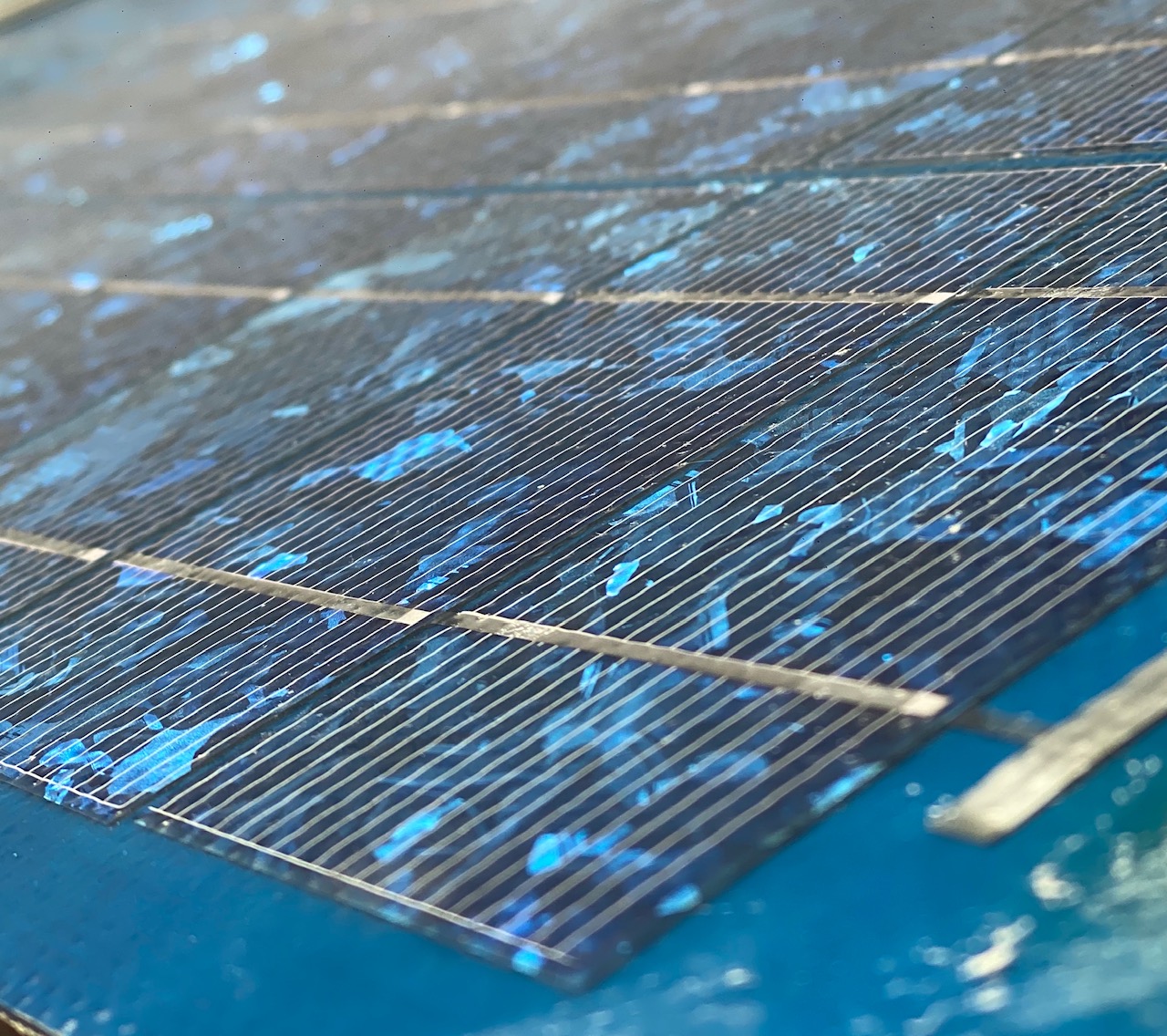
Silver Nanoparticle Publications
Publications related to producing silver nanoparticles from the SDR or spinning disc reactor Silver Nanoparticle Publications
We develop technology. You license | Build | Sell to your Customers. We can get you customers, even build your website. You build the technology... More Info
The Micro Robots are Coming: Our newest project making miniature robots for working and making electrodes for our new Saltwater Battery... More Info
Saltwater Battery: Our Salgenx Saltwater Battery and Desalination... More Info
Heat Pump Turbine: High COP heat pump that drives a turboshaft for AI cooling and hydraulic power... More Info
Coming Soon: The Filemaker AI Assistant does the work of 5 people... More Info

|
Silver Nanoparticle Publications Publications related to producing silver nanoparticles from the SDR or spinning disc reactor Silver Nanoparticle Publications |
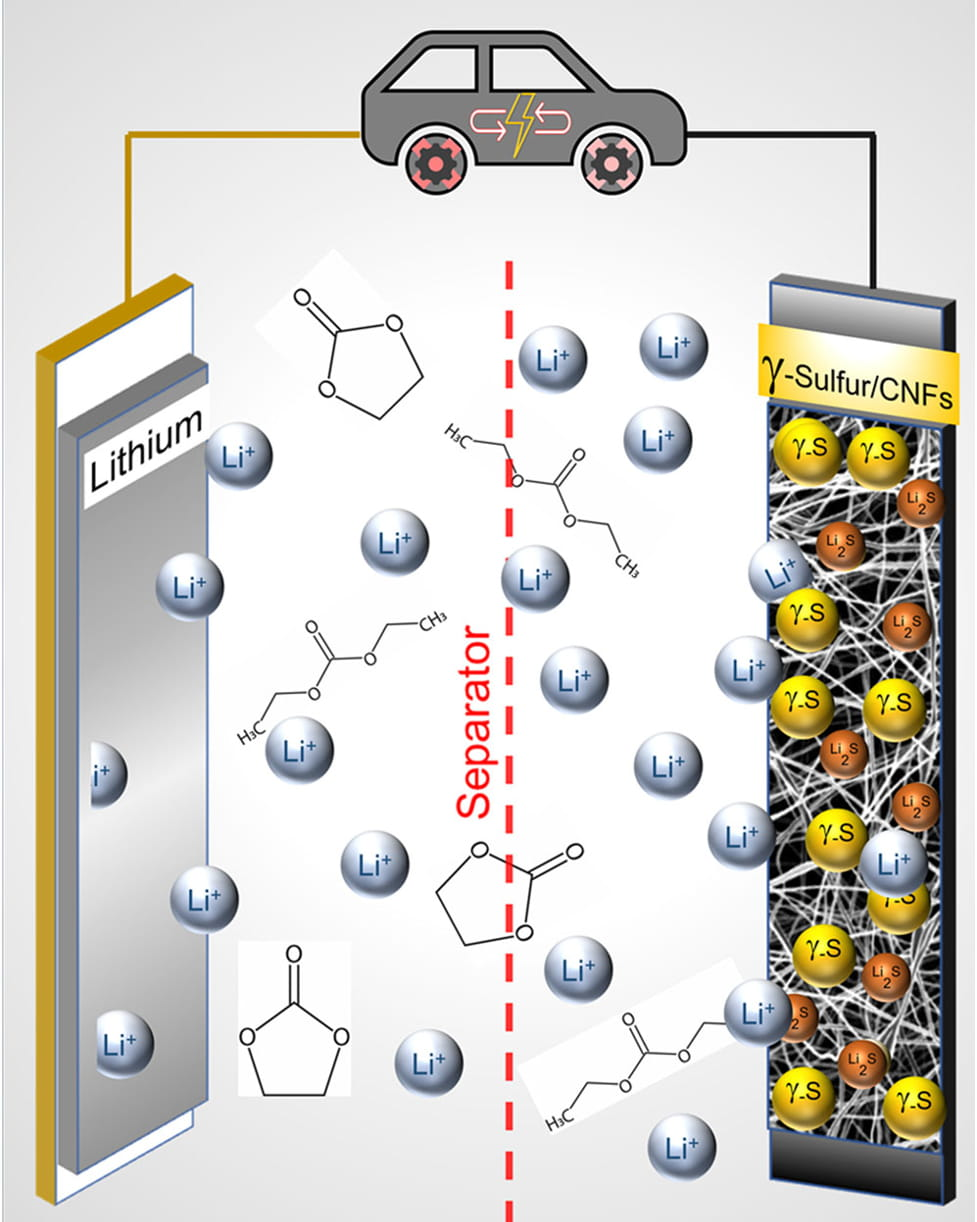
The schematic from the research team shows how the presence of gamma sulfur in their novel electrode prevents the formation of unwanted side-products during the electrochemical charge-and-discharge process. (Pai et al, 2022) |
Monoclinic Gamma-phase Sulfur Publications Abstract: Here, we stabilize a rare monoclinic γ-sulfur phase within carbon nanofibers that enables successful operation of Lithium-Sulfur (Li-S) batteries in carbonate electrolyte for 4000 cycles. Carbonates are known to adversely react with the intermediate polysulfides and shut down Li-S batteries in first discharge. Through electrochemical characterization and post-mortem spectroscopy/ microscopy studies on cycled cells, we demonstrate an altered redox mechanism in our cells that reversibly converts monoclinic sulfur to Li2S without the formation of intermediate polysulfides for the entire range of 4000 cycles. To the best of our knowledge, this is the first study to report the synthesis of stable γ-sulfur and its application in Li-S batteries. We hope that this striking discovery of solid-to-solid reaction will trigger new fundamental and applied research in carbonate electrolyte Li-S batteries. Stabilization of gamma sulfur at room temperature to enable the use of carbonate electrolyte in Li-S batteriesBreakthrough in Cathode Chemistry Clears Path for Lithium-Sulfur Batteries |
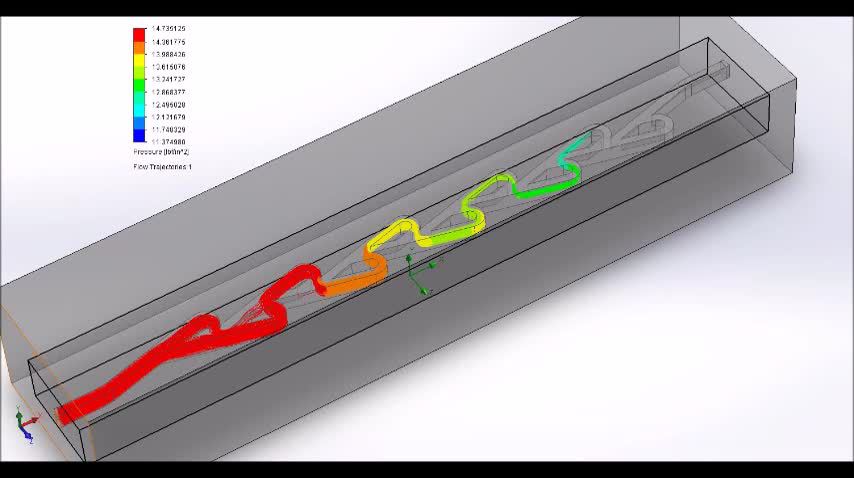
|
Nikola Tesla Patents Publications This is a complete listing of Nikola Tesla Patents. Nikola Tesla Patents Publications
|

|
Radial Outflow Turbine Publications Publications related to the Radial Outflow Turbine. Radial Outflow Turbine Publications |

|
Waste Heat to Energy Publications Publications for waste heat to energy. Waste Heat to Energy PublicationsWaste Heat to Energy is a renewable energy field which deploys technology to utilize industrial, commercial, and home based heat which would otherwise be unused, to make power. Since much of the quality of this heat is low, efficiency to capture and convert to power is also low. This makes the most sense (payback) where utility (grid-based) power rates are at or above $.15 per kwh. Keywords: wood pellets, silo, smoldering fire, explosion, carbon dioxide, static electricity, steam, electrostatic charge, supercritical CO2, subcritical CO2, liquid CO2, lithium ion battery electrolytes, lithium ion battery, recycling, radial turbine design, waste heat recovery, Wasteheat,heatrecovery,thermoelectricgenerator,electricitygeneration, tribo effect, TENG, Triboelectricity, triboelectric materials, thickness layer,contact surface area, Organic Rankine Cycle, Power Generation, Energy System, Design, Build, Capstone Turbine, Microturbine, Binary Power Plant, Organic Rankine Cycle, Matching and Optimization, Two-phase Geothermal Resources, High Enthalpy, Recuperator, Geothermal Comb Summary of Abstracts: Carbon dioxide not suitable for extinguishment of smouldering silo fires: static electricity may cause silo explosion: [ CO2 develops a large static charge which may result in a corona discharge, when used in Fire Extinguishers. May be a alternative (static DC) energy source when used in a ORC phase change system. ] Carbon dioxide is generally available as a liquid under high pressure. When discharged, small particles of dry ice are formed. The rapid flow of particles can generate considerable amounts of static electricity, which can act as a source of ignition if ignitable pyrolysis gasses are present. This article discusses a serious wood pellet smouldering fire and silo explosion in Norway in 2010, which took place when firefighters discharged portable CO2 fire extinguishers into the headspace. The attempt to suppress the fire may have ignited pyrolysis gasses. The article examines selected guidelines, standards, popular wood pellet handbooks and other literature and argues that the electrostatic hazard is widely under-appreciated. In the past, major explosions have been attributed to electrostatic ignition of flammable vapours during the release of CO2 for fire prevention purposes. There is evidence to suggest that those early lessons learned have at least partly passed out of sight. Electrostatic Effects of Charged Steam Jets: [ May be a significant source of static DC. ] Wet steam during expansion develops a electrostatic charge which interacts with the environment. Drop evaporation produces a discharging drift current. The result is an electrostatic ignition hazard. The Role of Sub- and Supercritical CO2 as Processing Solvent for the Recycling and Sample Preparation of Lithium Ion Battery Electrolytes: [ Supercritical CO2 can be used to recycle Lithium batteries. ] Quantitative electrolyte extraction from lithium ion batteries (LIB) is of great interest for recycling processes. extraction is a necessary tool for LIB electrolyte aging analysis as well as for post-mortem investigations in general, because a qualitative overview can already be achieved after a few minutes of extraction for well-aged, apparently dry LIB cells, where the electrolyte is deeply penetrated or even gellified in the solid battery materials. Thermodynamic Study of a Combined Power and Refrigeration System for Low-Grade Heat Energy Source: This study focuses on the thermal performance analysis of an organic Rankine cycle powered vapor compression refrigeration cycle for a set of working fluids for each cycle, also known as a dual fluid system. Further, a combination of R123 in the refrigeration cycle with propane in the Rankine cycle was scrutinized for their highest efficiency value of 16.48% with the corresponding highest coefficient of performance value of 2.85 at 40 C. Analytical and Experimental Study of Thermoelectric Generator (TEG) System for Automotive Exhaust Waste Heat Recovery: Nearly 70 percent of the energy produced from automotive engines is released to the atmosphere in the form of waste energy. The recovery of this energy represents a vital challenge to engine designers primarily when a thermoelectric generator (TEG) is used, where the availability of a continuous, steady-state temperature and heat flow is essential. The potential of semi-truck engines presents an attractive application as many coaches and trucks are roaming motorways at steady-state conditions most of the time. This study presents an analytical thermal design and an experimental validation of the TEG system for waste heat recovery from the exhaust of semi-truck engines. Generation of 3D Turbine Blades for Automotive Organic Rankine Cycles: Mathematical and Computational Perspectives: Organic Rankine cycle technology is gaining increasing interest as one of potent future waste heat recovery potential from internal combustion engines. The turbine is the component where power production takes place. Therefore, careful attention to the turbine design through mathematical and numerical simulations is required. As the rotor is the main component of the turbine, the generation of the 3D shape of the rotor blades and stator vanes is of great importance. Despite the strong vortices, the mathematical model proved to be an effective and fast tool for the generation of the 3D shapes of turbine blades and vanes. Overview of the Development and Application of the Twin Screw Expander: The development of renewable energy and recovery of low-grade waste heat in industry is the key to solve the problem. As a type of volumetric expander with full flow expansion, the screw expander is extensively applied in the industrial waste heat recovery and geothermal energy generation industry because of its effective utilization of low enthalpy energy. Improving the performance of the screw expander as the core, the paper concludes and summarizes the research status of the leakage, rotor geometry, sealing and lubrication, processing and manufacturing, which can affect the performance of the screw expander. Experimental Performance Analysis of a Small Thermoelectric System Applicable to Real-Time PCR Devices: The efficient use of energy from waste heat from the ISS away from the Earth is very important to the efficient operation of the ISS. To develop a thermoelectric module that can be used for real-time polymerase chain reaction (PCR) machinery used in biological and medical research, we simulated and evaluated the thermoelectric waste heat recovery system. Triglycerides as Novel Phase-Change Materials: A Review and Assessment of Their Thermal Properties: Latent Heat Storage (LHS) with Phase-Change Materials (PCMs) represents a high energy density storage technology which could be applied in a variety of applications such as waste heat recovery and integration of renewable energy technologies in energy systems. To increase the sustainability of these storage solutions, PCMs have to be developed with particular regard to bio-origin and biodegradability. Triglycerides represent an interesting class of esters as the main constituents of animal and vegetable fats, with attractive thermal properties. Supercritical Carbon Dioxide(s CO2) Power Cycle for Waste Heat Recovery: A Review from Thermodynamic Perspective: Supercritical CO2 p ower cycles have been deeply investigated in recent years. However, their potential in waste heat recovery is still largely unexplored. This paper presents a critical review of engineering background, technical challenges, and current advances of the sCO2 cycle for waste heat recovery. Firstly, common barriers for the further promotion of waste heat recovery technology are discussed. Afterwards, the technical advantages of the sCO2 cycle in solving the abovementioned problems are outlined by comparing several state-of-the-art thermodynamic cycles. Nanogenerators as a Sustainable Power Source: State of Art, Applications, and Challenges: A sustainable power source to meet the needs of energy requirement is very much essential in modern society as the conventional sources are depleting. Bioenergy, hydropower, solar, and wind are some of the well-established renewable energy sources that help to attain the need for energy at mega to gigawatts power scale. Nanogenerators based on nano energy are the growing technology that facilitate self-powered systems, sensors, and flexible and portable electronics in the booming era of IoT (Internet of Things). The invention of nanogenerators is a breakthrough in the field of ambient energy-harvesting techniques as they are lightweight, easily fabricated, sustainable, and care-free systems. Parametric Assessment on the Advanced Exergy Performance of a CO2 Energy Storage Based Trigeneration System: The turbine efficiency produces a higher impact on overall exergy destruction than compressor efficiency. The pinch temperature in cold storage causes the highest effect on exergy destruction amongst all the heat exchangers. There exists an optimum value in the compressor inlet pressure and ambient temperature. Carbon Dioxide Mixtures as Working Fluid for High-Temperature Heat Recovery: A Thermodynamic Comparison with Transcritical Organic Rankine Cycles: This study aims to provide a thermodynamic comparison between supercritical CO2 cycles and ORC cycles utilizing flue gases as waste heat source. Moreover, the possibility of using CO2 mixtures as working fluids in transcritical cycles to enhance the performance of the thermodynamic cycle is explored. ORCs operating with pure working fluids show higher cyclic thermal and total efficiencies compared to supercritical CO2 cycles; thus, they represent a better option for high-temperature waste heat recovery provided that the thermal stability at a higher temperature has been assessed. The results show that a total efficiency of 0.1476 is obtained for the CO2-R134a mixture (0.3 mole fraction of R134a) at a maximum cycle pressure of 200 bars, which is 15.86 percent higher than the supercritical carbon dioxide cycle efficiency of 0.1274, obtained at the comparatively high maximum pressure of 300 bars. Steam cycles, owing to their larger number of required turbine stages and lower power output, did not prove to be a suitable option in this application. Investigation of a Radial Turbine Design for a Utility-Scale Supercritical CO2 Power Cycle: Mechanical stress calculations show that the current blade design flow path of the rotor experiences tolerable stress values, however a more detailed re-visitation of disc design is necessitated to ensure an adequate safety margin for given materials. A discussion of the enabling technologies needed for the adoption of a mid-size radial turbine is given based on current advancements in seals, bearings, and materials for supercritical CO2 cycles. Waste Heat Recovery Technologies and Applications: Industrial waste heat is the energy that is generated in industrial processes which is not put into any practical use and is lost, wasted and dumped into the environment. Recovering the waste heat can be conducted through various waste heat recovery technologies to provide valuable energy sources and reduce the overall energy consumption. Techniques are considered such as direct contact condensation recovery, indirect contact condensation recovery, transport membrane condensation and the use of units such as heat pumps, heat recovery steam generators (HRSGs), heat pipe systems, Organic Rankine cycles, including the Kalina cycle, that recover and exchange waste heat with potential energy content. Furthermore, the uses of new emerging technologies for direct heat to power conversion such as thermoelectric, piezoelectric, thermionic, and thermo photo voltaic (TPV) power generation techniques are also explored and reviewed. In this regard, the functionality of all technologies and usage of each technique with respect to their advantages and disadvantages is evaluated and described. Energy Harvesting from the Waste Heat of an Electrical Oven via Thermoelectric Generator: This paper presents an attempt to generate the electricity by recovering the waste heat of an electrical oven. An experimental work has been done to investigate the electricity production by using a thermoelectric generator (TEG). This power could be used for charging a cell phone or light emitting diodes LEDs during cooking. Fundamental theories and basic principles of triboelectric effect: Long-term observation of the triboelectric effect has not only proved the feasibility of many novel and useful tribo-devices (e.g., triboelectric nanogenerators), but also constantly motivated the exploration of its mysterious nature. In the pursuit of a comprehensive understanding of how the triboelectric process works, a more accurate description of the triboelectric effect and its related parameters and factors is urgently required. Triboelectric effect in energy harvesting: The triboelectric effect converts mechanical energy into electrical energy based on the coupling effect of triboelectrification and electrostatic induction and is utilized as the basis for triboelectric generators (TEG). TEG's are promising for energy harvesting due their high output power and efficiency in conjunction with simple and economical production. Due to the wide availability of materials and ease of integration, in order to produce the triboelectric effect such functional materials are effective for wearable energy harvesting systems. Shining Light on Triboelectric Phenomena: These electrical machines, where the mechanical energy is converted to electricity by rubbing together two surfaces, would later be called triboelectric generators. Recently, there has been a resurgent interest in triboelectric generators for niche situations. In the modern world, very small and localized electrical power is sometimes needed for example, to power a sensor or small LED. Triboelectric Nanogenerators as New Energy Technology for Self-Powered Systems and as Active Mechanical and Chemical Sensors: Triboelectrification is an effect that is known to each and every one probably since ancient Greek time, but it is usually taken as a negative effect and is avoided in many technologies. We have recently invented a triboelectric nanogenerator (TENG) that is used to convert mechanical energy into electricity by a conjunction of triboelectrification and electrostatic induction. Influence of Thickness and Contact Area on the Performance of PDMS-Based Triboelectric Nanogenerators: Triboelectric nanogenerators (TENGs) are an emerging mechanical energy harvesting technology that was recently demonstrated. Due to their flexibility, they can be fabricated in various configurations and conse- quently have a large number of applications. Here, we present a study on the influence of the thickness of the triboelectric layer and of the contact surface area between two triboelectrical materials on the electric signals generated by a TENG. Supercritical CO2 Radial Turbine Design Performance as a Function of Turbine Size Parameters: Supercritical CO2 cycles are considered a promising technology for next generation concentrated solar thermal, waste heat recovery and nuclear applications. Particularly at small scale, where radial inflow turbines can be employed, using sCO2 results in both system advantages and simplifications of the turbine design, leading to improved performance and cost reductions. This paper aims to provide new insight towards the design of radial turbines for operation with sCO2 in the 100 to 200kW range. The design approach for supercritical CO2 gas turbine: Nowadays the engineers are paying a great interest in the development of power plants for electricity production with zero greenhouse gas emissions. Oxy-fuel combustion cycle is a promising technology requiring detailed turbomachine development. This study presents the results of preliminary flow path design of a supercritical carbon dioxide gas turbine. Recycling Printed Circuit Board Wastes Through Supercritical Fluid Delaminating: Supercritical fluid technology is a new technology being extensively studied in the past two decades. The research on application of supercritical fluid to PCB recycling is an attempt to equip the recycling industry with the state-of-the-art technique to achieve better economic benefits and environmental objectives. Through the exploratory research and the systematic study, it is proved that the SCF CO2 treatment of PCBs is promising in decomposing bonding materials between various PCB layers to cause delaminating of the boards. Equipped with the above five major advantages, this alternative process for PCB recycling is worth of further research to turn it into a real industrial technique to address the economic and environmental issues in current PCB recycling industry. In situ Synthesis of Gold Nanoparticles inside the Pores of MCM‐48 in Supercritical Carbon Dioxide and its Catalytic Application: Supercritical carbon dioxide alone can provide a unique environment for stabilizing gold nanoparticles in the channels of the cubic mesoporous MCM‐48 support and exquisite control of the particle size without perturbing the support structure. The synthesized material is highly stable, recyclable and no metal nanoparticle leaching was observed. The selective hydrogenation of crotonaldehyde with the synthesized material provides convincing evidence that the particles are inside the pores and available to the reactant molecules. Effect of Plasma Leading Edge Tubercles on Wing Performance: The effect of the sinusoidal leading edge known as tubercles, as seen on humpback whales, is achieved on a wing using Dielectric Barrier Discharge (DBD) plasma actuators. Circular shaped plasma actuator is designed to achieve this effect so that when activated it alters the flow field by formation of bubble-like regions. Properties of circular shaped plasma actuators are investigated experimentally for both steady and duty cycle mode in quiescent air using PIV technique to determine the optimum plasma actuator design and operating conditions. Plasma Actuators In Aircraft wing: A thin plasma actuator to suppress flow separation occurring around the leading-edge.The actuation was produced with a plasma sheet device (PSD) consisting in two bare electrodes flush mounted on the surface of the wing profile operated to obtain a discharge contouring the body in the inter electrode space. It is operated to obtain a discharge following the aerofoil leading edge curvature and acting over 90 percent of the span. Aerodynamic Control Using Windward-Surface Plasma Actuators on a Separation Ramp: Wind-tunnel experiments were conducted on a 47-deg sweep, scaled 1303 unmanned air vehicle model to assess the performance of an innovative windward-surface plasma actuator design for flight control at low angles of attack. Control was implemented by altering the flow past an aft separation ramp on the windward side using a single dielectric barrier discharge plasma actuator. Plasma actuators for aeronautics applications: The goal of this paper is to make a detailed review of the designs and associated setups of the different aerodynamic plasma actuators developed these last twenty years. First, some basic aspects of aerodynamic and their consequences in aeronautics are exposed. Then, the different aerodynamic conventional and plasma actuators are presented. Finally, the limits and the prospects of plasma actuators considered for airflow control are discussed. Utilization of Thermal Effect Induced by Plasma Generation for Aircraft Icing Mitigation: An explorative investigation was performed to demonstrate the feasibility of using a thermal effect induced by dielectric-barrier-discharge plasma generation for aircraft icing mitigation. The experimental study was performed in an icing research tunnel available at Iowa State University. A NACA 0012 airfoil/wing model embedded with dielectric-barrier-discharge plasma actuators was installed in the icing research tunnel under typical glaze-/rimeicing conditions pertinent to aircraft inflight icing phenomena. Optimization of Dielectric Barrier Discharge Plasma Actuators for Icing Control: Plasma flow control has received growing research attention in the past few decades for its unique features, such as no moving parts, fast response, and exceptional ease of installation on the surface without changing the shape. One such significant development is the use of surface dielectric barrier discharge (SDBD) plasma actuators, which are composed of two electrodes separated by a dielectric material arranged in an asymmetric fashion. Electric, hybrid, and turboelectric fixed-wing aircraft: Following high-profile government and industry studies, electric aircraft propulsion has emerged as an important research topic. This article surveys the scholarly and business literature on fixed-wing aircraft propelled in whole or in part by electricity. This includes all-electric, hybrid electric, and turboelectric architectures. Geothermal energy potential of Indian oilfields: Geothermal energy is one of the renewable energy sources that have gained extensive recognition as an alternative energy source to fossil fuel energy because of its sustainability and low impact on the environment. However, in spite of the benefits of geothermal energy, drilling costs often hinders the development of geothermal fields for production. Opportunities for Synergy Between Natural Gas and Renewable Energy in the Electric Power and Transportation Sectors: Use of both natural gas and renewable energy has grown significantly in recent years. Both forms of energy have been touted as key elements of a transition to a cleaner and more secure energy future, but much of the current discourse considers each in isolation or concentrates on the competitive impacts of one on the other. This paper attempts, instead, to explore potential synergies of natural gas and renewable energy in the U.S. electric power and transportation sectors. Application of Organic Rankine Cycles (ORC): Organic Rankine Cycle (ORC) is a technology that can convert thermal energy at relative low temperatures in the range of 80 to 350 C to electricity. This opens up the possibility to exploit low-grade heat that otherwise would be wasted. It can play an important role to improve the energy efficiency of new or existing energy-intensive applications. The aim of this project is to estimate the potential of new ORC applications. Thermodynamic Analysis of Organic Rankine Cycle with Hydrofluoroethers as Working Fluids: This paper presents an analysis of organic Rankine cycle (ORC) using hydrofluoroethers including HFE7000, HFE7100 and HFE7500 as working fluids under constant external conditions. Therefore, HFE7000 can be recommended to be used as working fluid in ORC to convert low-grade heat into power. Improving Recovery of Waste Heat in Industrial Processes: Waste heat from turbines and engines used in industrial ap- plications along with waste heat from industrial processes are exceptionally abundant sources of energy. If even a fraction of this waste heat could be economically converted to useful electricity, it would have a tangible and very positive impact on the economic health, energy consumption, and carbon emis- sions in the U.S. manufacturing sector. The current waste heat recovery technologies, including ORC systems and thermoelec- trics, are technically feasible but in many cases economically unattractive. This limits their current use to a small number of niche applications. Economic Implementation of the Organic Rankine Cycle in Industry : An organic rankine cycle operates under the same principle as a steam rankine cycle, but with a lower operating temperature and pressure. These operating conditions are a result of substituting, into the closed loop system, a working fluid other than water. This allows a lower grade heat to act as a fuel for operation. The organic rankine cycle can be used in conjunction with a steam rankine cycle to recapture waste heat and improve overall system efficiency. A study was conducted in order to find feasible waste heat recovery applications and the industries which would benefit most from those applications. Using numerical analysis, backed by several case studies, it is determined that an organic rankine cycle can be a useful and economical means of waste heat recovery. DESIGN AND BUILD OF A 1 KILOWATT ORGANIC RANKINE CYCLE POWER GENERATOR: Organic Rankine Cycle (ORC) systems are capable of utilising low-enthalpy geothermal sources. The aim of the Above Ground Geothermal and Allied Technologies (AGGAT) research programme is the development of ORC systems within New Zealand. An experimental scale ORC system, known as ORC-B, was built at the University of Canterbury to assist with the research and development of the system design and component selection process. The unit is a 1 kW ORC consisting of four key components: evaporator, expander, condenser and pump. Selection of the working fluid was found to be a constraining factor in the design. A refrigerant mix known as HFC-M1 was selected due to its desirable performance, high safety and ease of availability in New Zealand. The heat source for the system is the exhaust of a Capstone gas turbine. Organic Rankine Cycle Configurations: In the last two decades the binary power plant, utilizing the Organic Rankine Cycle (ORC), has become a preferred means of exploiting low to moderate enthalpy geothermal resources. It has been widely used to utilize the brine in existing single flash plants and in many other applications as an efficient and reliable way of employing a geothermal resource, in the form of brine only or brine and low pressure steam coming from a separator. Over the years the basic ORC has been improved and modified to better adapt the cycle to various conditions of the heat source. |
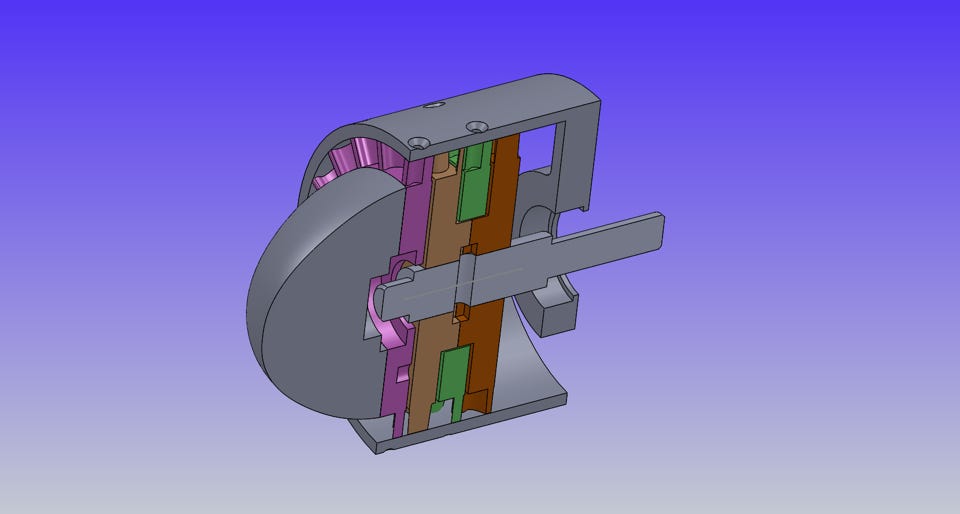
|
Electric Turbine Topics include:- aircraft technology and innovation- static plasma wings and plasma deicing- electronic turbine propulsion- acoustic problems with jet engines- electric nanogenerator- concepts of classical jet propulsion- triboelectric nanogenerator- anti-icing method of airfoil pulsed dielectric barrier discharge plasma- fundamentals of electric propulsion ion and hall thrusters- jet propulsion by microwave air plasma - nano mechanics quantum size effects contacts triboelectricity- air breathing plasma jet propulsion concept- optimization dielectric discharge plasma actuators icing control- plasma actuators hingeless aerodynamic control uav and drones- stall control by plasma actuators along airfoil span Electric Turbine | Static Thrusters | Plasma Wing |
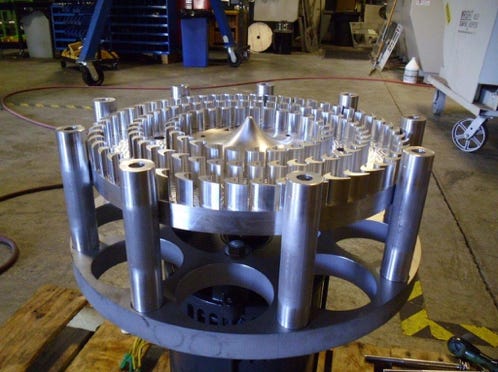
|
Combined Heat and Power CHP Various publications related to combined heat and power.- Texas Geothermal- Argonon Sustainable Ship- 250 kW Carrier Micro Steam Heat Recovery Turbine- Infinity GPU- Cain Economizers- Cain Heat Recovery Units- Chena Hot Springs Geothermal to Power- CHP- Volcanic Geothermal- Ramgen Shockwave Turbine Compressor- PureCycle 280 Manual and Datasheet- Tesla Turbine- Waste Heat Utilization Waste Heat to Energy Combined Heat and Power
|
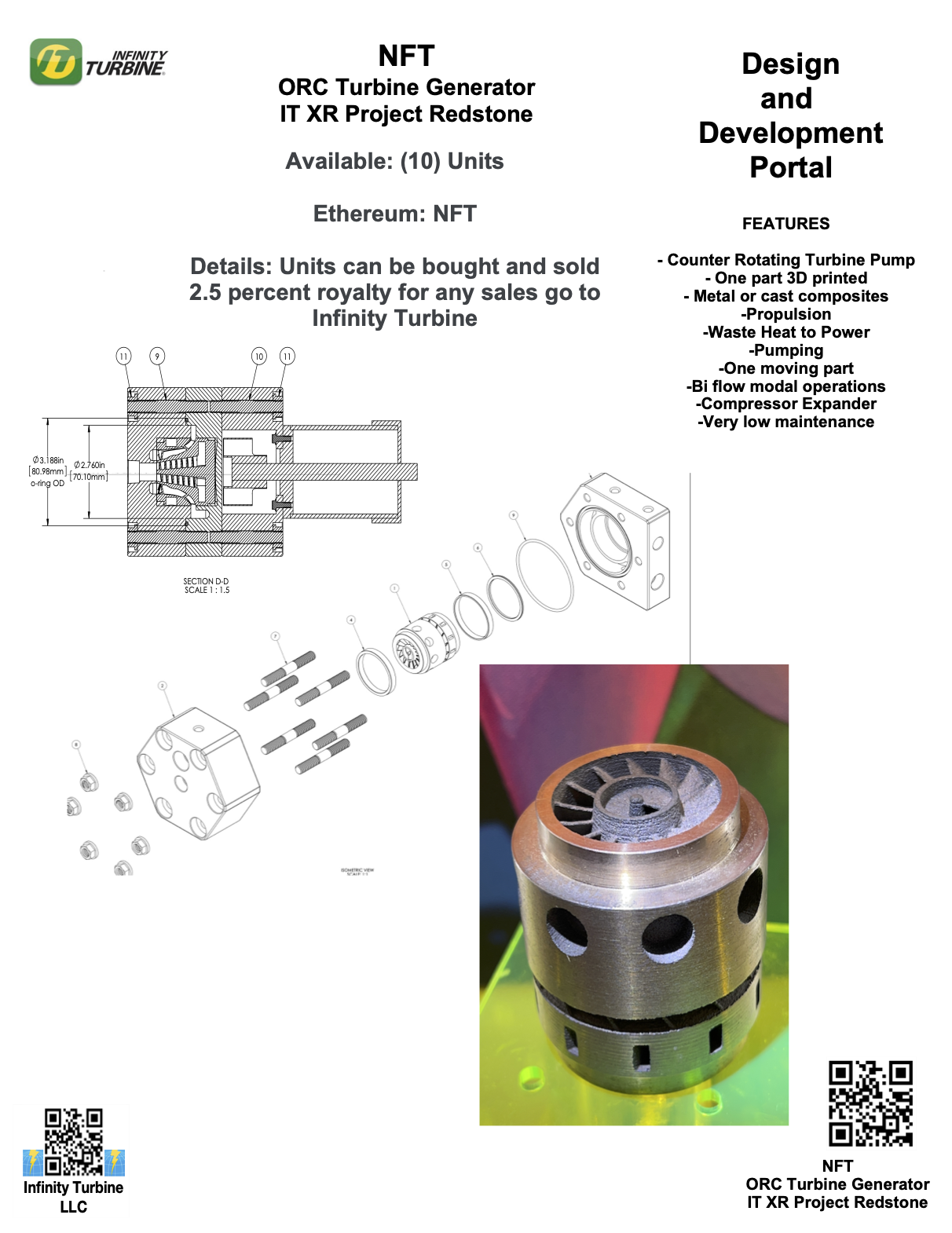
|
NFT NFT Publications. NFT Publications
|
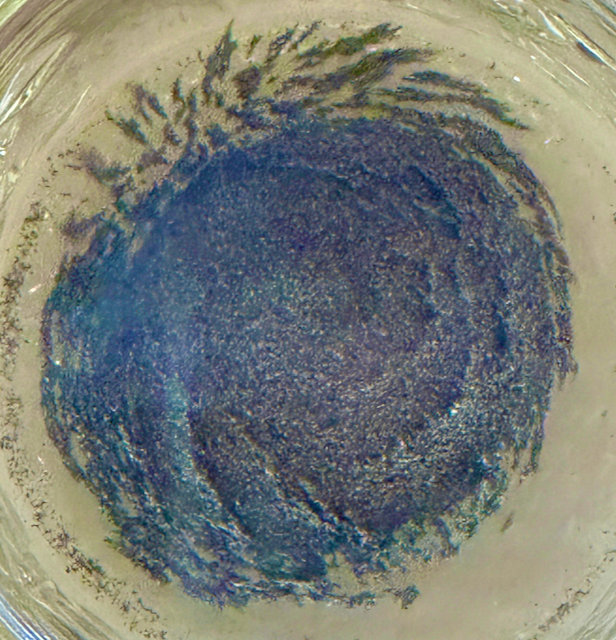
Experimenting using liquid electrode to develop a process to make graphene |
Exfoliated Graphene Under development using electrochemistry as a side of the Salgenx flow battery is making graphene.There are many similarities and the use of sodium (Na) to exfoliate graphene from graphite.Na is harvested during the Salgenx Flow Battery charging process. Electro-Exfoliation of Graphite to Graphene in an Aqueous Solution of Inorganic Salt |
| CONTACT TEL: 608-238-6001 Email: greg@infinityturbine.com | RSS | AMP | PDF | IG | X.com | Free Tesla Supercharger Miles |